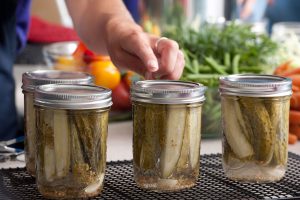Food Preservation
 Rising food costs have persuaded more than the usual number of Mainers to plant gardens. You may be thinking about preserving your harvest for the first time—or dusting off old canning equipment. If you plan to can garden surplus this year, be sure to get up-to-date information. Updated recommendations are as close as your local UMaine Extension office: call 800.287.0274 to find an office near you.
Rising food costs have persuaded more than the usual number of Mainers to plant gardens. You may be thinking about preserving your harvest for the first time—or dusting off old canning equipment. If you plan to can garden surplus this year, be sure to get up-to-date information. Updated recommendations are as close as your local UMaine Extension office: call 800.287.0274 to find an office near you.
A national survey conducted by the USDA-NIFA National Center for Home Food Preservation in 2000 found that many people use canning practices that put them at high risk for foodborne illness. Over the years, changes in scientific expertise as well as canning equipment have occurred, so there is new information on the right type of methods, canners, jars, and seals. For instance, there are two types of canners for home canning: the boiling water-bath canner and the pressure canner. Using the pressure canner for low-acid foods such as vegetables, meats, poultry, and fish is a must to prevent botulism. The water-bath canner is used for high-acid foods such as fruits, jams, and jellies.
The first step is to take an inventory of your canning supplies to determine what you have and what you might need. Be careful to make sure the gasket on your pressure canner is in good condition, and get your dial gauge tested annually. Pressure canner gauges can be tested at most UMaine Extension offices, and some offices are offering hands-on workshops and webinars.
Related Resources
- “Let’s Preserve” Fact Sheets: Food Preservation (Cooperative Extension Publications)
- Can Home Canned Food Spoil?, Bulletin #4277 (Cooperative Extension Publications)
- Canning & Freezing Quick Guides: Food Preservation (Cooperative Extension Publications)
- Using Home Preserved Foods Safely, Bulletin #4273 (Cooperative Extension Publications)
- USDA Complete Guide to Home Canning
- National Center for Home Food Preservation (University of Georgia)
